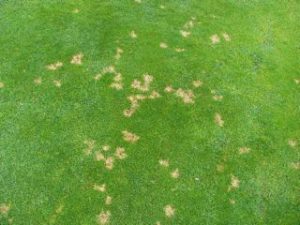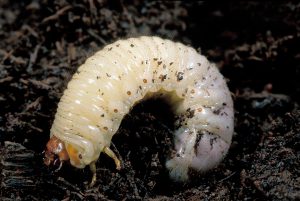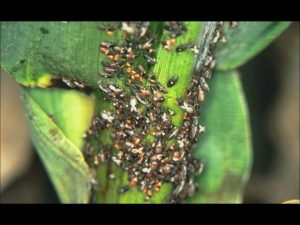Brown grass has been the eyesore of neighborhoods everywhere since lawns became a thing in Europe during the 1500s. Lawns have been around for as long as America has. As long as lush, Eden-esque lawns have been here, so have the shriveled, yellowed lawns that we have come to associate with cul-de-sac eyesores and bad neighbors.
Lawns aren’t just a status symbol (even though that’s what they started as)—they have countless economic, environmental, and health benefits, too. For example, did you know that medical patients with a view of greenery recover faster than patients without those views? Also, did you know that lawns increase property value by up to 11%? (Not to mention that lawns have a 100–200% recovery rate, which means you get at least all of the money back that you spend on them—and up to double—when you sell your house). Also, lawns act as natural filters of both water and air, and are 2,000 times better at erosion control than bare soil. Of course, none of this applies to lawns that are brown, because those lawns are dormant, dying, or dead. You might think that all a brown lawn needs is some extra water, and sometimes, that’s the case. But if your lawn has a problem that water makes worse—for example, a water-loving fungus—you’re just sending your grass into a wet, early grave. Read on for a deep dive into brown grass: why it happens, when it happens, and what to do when it does.
The Anatomy of Grass
Grass has three main parts: the roots, the crown, and the leaves (though you probably call these the blades). The leaves absorb sunlight and sometimes oxygen from the air, while the roots absorb water, nutrients, and oxygen from the soil. The crown is where the root and leaves of a grass blade meet, and it is where the grass grows upwards from. Grass crowns are very close to the ground. They are the reason you can cut grass again and again but it will continue to grow. However, if the crown gets damaged, the grass plant cannot grow anymore. That’s why it’s bad to cut grass too low.
Grass is green because of a pigment it produces called chlorophyll. Chlorophyll is important because it absorbs the sun’s light and passes it along to other cells that convert that light to sugar. The process is called photosynthesis—you’ve probably heard of it. Though grass turns brown for all sorts of reasons, all brown grass has something in common: the grass lost the ability to produce its food and stopped chlorophyll production in an attempt to save energy. Chlorophyll absorbs red and blue light but reflects green light, which is why grass looks green to us.
Why is my grass turning brown, and what can I do about it?
Your grass is too dry or wet
This is typically people’s go-to when they imagine brown grass, because it’s obvious when an area is going through a drought or flood. We lumped dry and wet grass together because in both cases the grass’ roots lose the ability to take oxygen and other nutrients from the soil. You might not think of grass as needing oxygen, but it is actually essential for when the grass converts its sugar into food.
Sometimes it’s not nature, but your watering habits that kill your grass. It’s obvious why underwatering is dangerous, but overwatering is just as bad. If you don’t outright drown your grass, you’ll definitely stress it out, which makes it much more susceptible to other common brown-ers, like pests or disease. Also, you’ll need to use more fertilizer because instead of going to your grass, those nutrients are getting washed right down the drain.
Preventing over/underwatered grass
The best way to keep your grass from turning brown because of over/underwatering is by watering it the proper amount. Lawns only need an inch of water a week. Any more (or less) than that, and you risk a brown lawn. An easy way to tell how many inches you’re watering your grass is to take a measuring cup and put it in your grass when you water it. However long it takes for the cup to fill up to one inch of water is how long you should water your grass per week.
Treating over/underwatered grass
If your grass is brown because you’ve been watering it too much (or little), the best thing to do is to change your watering habits. We already went over how to tell how much you’re watering, so just adjust accordingly.
For dry grass that is brown, give it a little extra water. In three days, it should be green again. If it isn’t, it’s probably dead.
For wet grass that is brown, water less. If your grass is too wet because of heavy rainfall or other natural causes, you’ll have to be more creative. For example, if you have a pit in your yard where no grass will grow because all the rain flows there, then you could consider planting a rain garden there with plants that will thrive in the wetness. You could also alter your landscape to include a natural drain or redirect the water flow. If you are planning to alter your landscape, Clean Cut can help. We have landscape specialists who can help you alter your landscape and help your lawn look green and beautiful.
You’re cutting your lawn too short
Cutting the grass too short stresses and weakens your grass. If you cut your grass too low, you risk damaging the crown, and which can kill the grass outright. You also stress the grass when you cut too low and, in some cases, even expose the roots. Cutting the grass too low often doesn’t cause the grass to turn brown by itself, but it does make the grass much more susceptible to pests, disease, and drying out.
Preventing too-short lawns
The only way to keep from cutting grass too short is to find out your grass’ ideal cutting length. Kentucky Bluegrass is the most dominant grass in Ohio, and it’s ideal length is between 1.5 – 2.5 inches.
Treating too-short lawns
If your grass is brown because you cut it too low, it’s probably already dead. The best thing you can do is to plant new grass and take your newfound knowledge with you the next time you’re on the lawnmower.
Your lawnmower blades are ripping your grass
If your lawnmower blades are too dull, you will rip your grass apart instead of cutting it. This doesn’t make grass look much worse, especially not from far away, but it stresses the grass out a great deal. If the blades are dull enough, they will damage the grass all the way down to the crown, which will kill the plant.
Preventing ripped grass
You can prevent ripped grass by sharpening your lawnmower blades. There are many places in Ohio where you can get your lawnmower blades sharpened. We even grabbed a handy list of companies who offer the service here in Cincinnati. Getting your blades sharpened only costs around $10, and buying a new blade only costs about $15. Sharpening your blades on your own is also pretty easy to do. All you need is a mill bastard file. If you do decide to take on the underbelly if your lawnmower alone, remember that the blades don’t need to be razor sharp. In fact, they should be no sharper than a butter knife. Use this site to learn how.
Treating ripped grass
Unfortunately, there’s no real way to heal grass that has turned brown because it was cut with dull blades. The only thing to do is to sharpen those blades and know better for next time.
Your lawn has a disease
It turns out that almost all grass diseases are caused by fungi. Here, we will go over the two most common Ohio lawn diseases: dollar spot and brown patch.
Dollar Spot

Dollar spot is caused by a fungus called Sclelrotinia Homoeocarpa. It attaches to the leaves of grass and steals the sugar that they produce, killing the plant. The result is a small dead patch of grass that is usually no bigger than a silver dollar (hence the name). The fungus that causes dollar spot loves high humidity and warm daytime temperatures. It is most common on golf course turf, but it can affect regular grass, too.
Preventing dollar spot
The best way to prevent dollar spot is by watering your grass in the morning, not the evening. If you water later in the day, the sun will not bake off the excess water and your grass blades will stay wet overnight, which is perfect for the fungus and can even help the infection spread.
Also, fast-release nitrogen fertilizers promote fungus growth, because fungi are better at quickly absorbing nitrogen than grass is. Stick to slow-release nitrogen fertilizers to reduce the chances of your lawn contracting dollar spot.
Treating dollar spot
Fungicides are effective at treating dollar spot, but these are not always the best option because they’re bad for the environment and dangerous to pets and/or children. However, other treatment options for dollar spot are limited.
Brown Patch
Brown patch is the most common (and deadly) turf disease out there. It is caused by a fungus called Rhizoctonia. Brown Patch looks the way it is named—brown patches suddenly appear on your grass, usually with a dark outer ring. If you look closely at the infected grass, you’ll notice brown spots on the blades. As the disease progresses, those brown spots will eventually engulf the whole blade, turning your grass brown. Brown patch is similar to dollar spot in that it prefers hot temperatures, high humidity, and fast-release nitrogen fertilizer. However, it is dissimilar because it prefers hot nighttime temperatures as well—around 70ºF.
Preventing brown patch
The best thing you can do is to de-thatch your lawn when the weather starts to get cooler. The thatch is a layer of dead grass and other lawn material on the ground that has not yet decomposed. It sits between the soil and the grass blades of your lawn. As the thatch builds, it steals water and light from the grass and its roots. Fungi love to hide out in thatches during the winter.
Keeping your lawnmower blades sharp is another way to prevent brown patch. Rhizoctonia enters the plant through wounds caused by cutting grass, so the cleaner the cut, the better.
Finally, avoid using fast-release nitrogen fertilizer for the same reasons discussed above.
Treating brown patch
One effective way to treat your grass once it has contracted Brown Patch is to make sure your grass is not any wetter than it needs to be. We already discussed good watering habits, but an effective way to prevent Brown Patch from spreading is to drag a hose over your lawn in the morning to get rid of all the dew that accumulated on it over the night. Fungicides are an effective last resort as well.
Your lawn has pests
Pests, like fungi, kill your lawn by robbing your grass of the nutrients it needs. Also like fungi, there are many pests that can affect your lawn, but we will talk about the most common and deadly ones in Ohio: grubs and chinches.
Grubs

Grubs are the larvae of beetles, and they are a threat to your lawn in every season except winter. Beetles lay eggs in the soil that hatch in the middle of summer. Two weeks after the eggs get laid, the grubs hatch and begin eating the roots of the grass. They do this for months until they have matured and the season shifts to fall. Once the weather cools down, they burrow down to prepare for winter and lay dormant for the season. In the early summer, the grubs finally mature into beetles and the whole process begins again. Grubs can devastate a yard, so it’s important to get rid of them as soon as you notice them. A good way to tell if you have grubs is to look out for ravens or moles in your yard. If they’re there, it’s probably because they want to eat the grubs under your grass.
Prevention and treatment of grubs
Whether prevention or treatment is your goal, insecticides are pretty much your only option. There are two kinds of grub insecticides: those that prevent grubs next season, and those that kill current grubs. Preventative insecticides are more effective than curative ones (which, best-case, kill 80% of grubs), so if you have brown grass caused by grubs, your best bet is to wait out the season and apply insecticides to stave off the next generation.
Chinches

Chinch bugs are little 1/6 inch long bugs with black bodies and white wings on their backs. They eat the blades of your grass and secrete a liquid that prevents it from absorbing water, effectively suffocating it. Since they are so tiny, it’s often difficult to spot them. One trick is to cut both ends off a tin can (or any cylindrical can) to make a tube. Stick that tube in the ground and fill it halfway with water. If you have chinches, they will float to the top in about ten minutes. The type of chinch bug that prefers Ohio grass is called the hairy chinch, and they prefer warm and dry conditions.
Preventing hairy chinch bugs
The best and simplest way to prevent cinch bugs from getting your lawn is to make sure it is properly watered. Since the little bugs prefer dry conditions, regularly watered lawns tend to ward them off. Another natural way to prevent the bugs is to plant grass that is enhanced with endophytes, which are fungi that live in the grass and help to repel insects. Be careful, though. Endophytes are poisonous to animals, and this type of grass is not suitable for farmers or those with pets. Unfortunately, there are no preventative pesticides for chinch bugs.
Treating hairy Chinch bugs
Insecticides are an effective way to kill off chinch bug populations. However, take caution when you go this route, because the chinch bug has a natural predator called the big-eyed bug, and insecticides will kill both. Often, proper watering habits are enough to stave off chinch bug damage, but know that while many lawns have chinch bugs, it is rare that there are enough of them that they are actually damaging your lawn.
Dogs are peeing on your grass
Any homeowner with a dog knows that there are often yellow patches where your dog pees. These yellow patches come from what is called nitrogen burn, and they happen because dog urine has too high a concentration of nitrogen. Not only does this nitrogen kill your grass, but it also alters the pH of the soil, making it so that future grass cannot absorb nutrients from the soil, effectively stunting your grass’ growth for a few years.
Preventing nitrogen burn
It turns out that dog pee shouldn’t be naturally high in nitrogen. Dog urine is so nitrogen-rich because they are carnivores that are typically fed a cereal diet. Without going into too much detail, dog urine is supposed to be low in nitrogen. In fact, when dogs pee on the grass, it should be good for the grass. There are products out there that you sprinkle into your dog’s food that reduce the amount of nitrogen in their urine, but a better way that’s healthier for your dogs is to feed them a species-appropriate diet. For dogs, this often includes a lot of raw meat, but don’t just go throwing raw chicken to your dog every day! Species-appropriate diets for dogs are complicated and should not be started without consulting a vet. The wrong diet can seriously hurt your dog.
Another way to prevent nitrogen burn is to train your dog to pee in the bushes or other places.
Treating nitrogen burn
If you’ve already got those ugly patches, the only thing you can do is start anew. A good thing to do is to rake up the dead grass, apply a layer of extra-fine ground limestone, let the limestone sink into the soil for a week, add some topsoil, and plant new grass seed. Things will be looking green before you know it.
Other nutrient deficiencies
Grass is a living thing, with complex needs just like humans. So, sometimes your grass turns brown because your soil just isn’t providing it with the proper nutrients it needs. Diagnosing specific nutrient deficiencies in grass is difficult, but Clean Cut’s landscape experts can help. If you’ve got brown grass and don’t know what to do, call us today for a free estimate.

